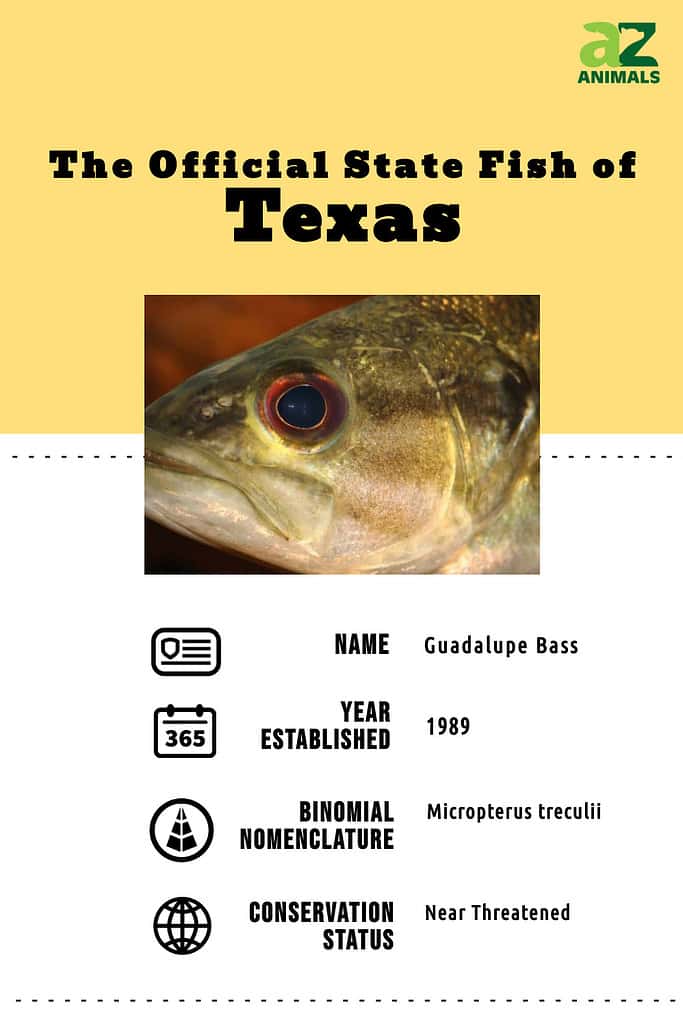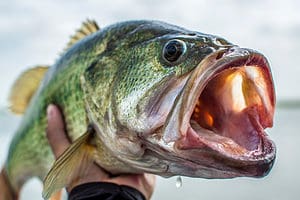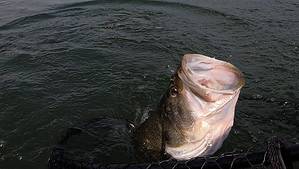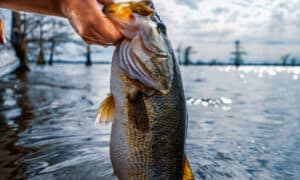Texas is a state located in the southern region of the United States. It’s known for its vast and diverse landscape, rich cultural heritage, and strong traditions. One such tradition among Texans is fishing. It’s an activity that has been ingrained in their way of life for generations. Discover the official Texas state fish.
Texas State Fish

The official Texas state fish is none other than the Guadalupe bass (Micropterus treculii). This freshwater fish species can be found only in Texas. It is revered by locals for its fighting spirit, beautiful markings, and delicious taste.
The Guadalupe bass is typically lighter in color than its relatives. Its distinguishing features include diamond-like spots along its lateral line, small diamond marks on its back, and a Rectangular tooth patch on its tongue. Additionally, the green coloring of a Guadalupe bass extends lower on the body than the coloring of a spotted bass. It doesn’t have vertical bars like smallmouth bass or an extended jaw like largemouth bass. If you’re looking to catch this species of fish, you can find them in Texas rivers.
The Guadalupe bass is sought out by anglers as a sport fish for its preference for fast-flowing waters. These fish can be found in small streams, often in picturesque settings, and specimens of up to 3.5 pounds have been caught.
Where to Catch
While catching this prized fish can be challenging, it’s not impossible. In fact, Dr. Bryan Townsend of Austin managed to reel in a record-breaking catch weighing 3.71 lb (3 lb, 11.36 oz) back in 2014 – an impressive feat for any angler!
For those looking to try their luck at catching this elusive fish themselves, there are plenty of prime spots throughout central Texas where you may find them lurking beneath the water’s surface.
While the largemouth bass is usually in still waters, the Guadalupe bass mainly resides in the northern and eastern Edwards Plateau. This includes the upstreams of the San Antonio River, the Guadalupe River past Gonzales, the Colorado River beyond Austin, and various areas of the Brazos River. It can also be found in much smaller numbers away from the Edwards Plateau. You can find them in the bottom portion of the Colorado River. There have also been reports of this species living in the Nueces River system as a result of human introduction.
Diet and Baiting

Guadalupe bass are fond of insects but will also eat other fish such as shad or baited fish pieces.
©Clinton & Charles Robertson from Del Rio, Texas & San Marcos, TX, USA / CC BY 2.0 – Original / License
When it comes to the diet of the official Texas state fish, there are a few things to keep in mind. First, it’s important to note that these fish have a particular affinity for insects. This is particularly true when they are young or in their later years. This means that if you’re trying to catch Guadalupe bass, using insect-based bait is likely to be very effective.
However, as the fish mature and become more predatory, they tend to shift towards larger prey. At their peak hunting ability, they will typically go after bait fish such as shad and smaller species of bass or bluegills. This is something else worth keeping in mind if you’re planning on targeting this type of fish.
Overall, understanding the dietary preferences of Guadalupe bass can help increase your chances of catching them successfully. Whether you opt for insect-based baits or larger prey options like shad and small bass, tailoring your approach based on what the fish are most likely to respond positively to can make all the difference when out on the water.
Fishing
The Guadalupe bass, while not as well-known as other species of fish, has a dedicated following among anglers in Central Texas. Renowned for its tenacity and strength, this fish is known to put up an impressive fight when hooked. With its powerful muscles and ability to manipulate the current of the water, catching a Guadalupe bass can be quite the challenge. Many fishermen relish the capture of this fish.
One trait that sets the official Texas state fish apart from others is its strikingly beautiful colors. Unlike spotted bass, which tend to have more muted tones, the Guadalupe bass boasts natural hues that are both vivid and eye-catching. This alone makes it a prized catch for many fishermen who appreciate the aesthetics of their sport.
Another factor that makes the Guadalupe bass appealing to anglers is its preference for strong currents. This “Texas brook trout,” as it’s sometimes called due to its insect-heavy diet and love of fast-moving waters, is particularly popular among fly fishermen who enjoy testing their skills against this challenging quarry.
When it comes to fighting style, the Guadalupe bass shares some traits with both smallmouth bass and rainbow trout. Like these other species, it will make long runs and attempt to manipulate current in order to evade capture. However, it also employs sharp turns and tries to entangle fishing lines on structures such as rocks or logs. These tactics are reminiscent of smallmouths in particular. Additionally, some lucky anglers may even witness this species making large leaps to escape capture.

Many Texas anglers relish catching a Guadalupe bass due to its intense combative skills.
©iStock.com/shironosov
Life Cycle
Both males and females of the Guadalupe bass species reach sexual maturity when they are one year old. The spawning season for them is from March to June. There is a possible secondary spawn in late summer or early fall. The males build gravel nests for spawning in shallow water with faster flow rates than largemouth bass. After the female lays her eggs (up to 9,000 of them), the male stays to guard them until they hatch. The fry feed on invertebrates and gradually switch to a more fish-based diet as they mature.
Threats
The Guadalupe bass is facing a unique threat; hybridization with the introduced smallmouth bass. This has caused many of the Guadalupe bass to become hybrids, which is a major concern. The Texas Parks and Wildlife Department has announced that they will be stocking many bass fish. They will focus on areas where rarely spotted bass subspecies are facing the same issue in order to combat the hybrid population.
Conservation Status
The Guadalupe bass is currently listed as a threatened species in Texas. This means that it faces significant population decline or habitat destruction. This designation was put in place to protect the fish from overfishing and pollution. Both of these issues are major threats to their survival.
Overfishing has been a problem for the Guadalupe bass due to their popularity among anglers. Many people find them an exciting catch and target them regularly, leading to the depletion of populations in certain areas. Additionally, pollution from agricultural runoff and urbanization has also impacted their habitats. This occurs by altering water quality and disrupting natural food sources.
The Texas Parks and Wildlife Department (TPWD) and other organizations have worked hard since 1991 to protect the Guadalupe bass species in 14 rivers of Central Texas. This includes the stocking of over 2.4 million fingerlings, restoring or preserving habitats, and managing riparian plants in eight watersheds. There are also efforts being made to assess, monitor, or restore additional populations of these fish. This includes another 13 rivers across Central Texas.
By working together with local fishing communities and conservation organizations, we can help protect these incredible fish for future generations to enjoy.
The photo featured at the top of this post is © Janece Flippo/Shutterstock.com
Thank you for reading! Have some feedback for us? Contact the AZ Animals editorial team.







